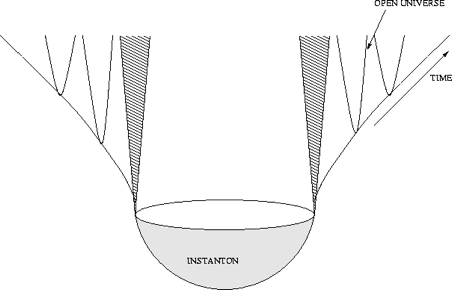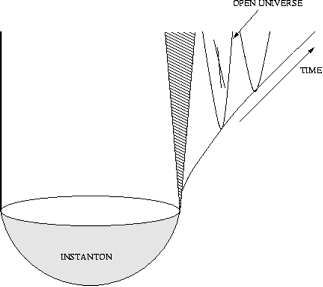Types of Instanton
People have found different types of instantons that can provide the initial conditions for realistic Universes. The first attempt to find an instanton that describes the creation of a Universe within the context of the 'no boundary' proposal was made by Stephen Hawking and Ian Moss. The Hawking-Moss instanton describes the creation of an eternally inflating Universe with 'closed' spatial three-geometries.
It is presently an unsolved question whether our Universe contains closed, flat or open spatial three-geometries. In a flat Universe, the large-scale spatial geometry looks like the ordinary three-dimensional space we experience around us. In contrast to this, the spatial sections of a realistic closed Universe would look like three-dimensional (surfaces of) spheres with a very large but finite radius. An open geometry would look like an infinite hyperboloid. Only a closed Universe would therefore be finite. There is, however, nowadays strong evidence from cosmological observations in favour of an infinite open Universe. It is therefore an important question whether there exist instantons that describe the creation of open Universes.
Coleman-De Luccia Instanton
The idea behind the Coleman-De Luccia instanton, discovered in 1987, is that the matter in the early Universe is initially in a state known as a false vacuum. A false vacuum is a classically stable excited state which is quantum mechanically unstable. In the quantum theory, matter which is in a false vacuum may 'tunnel' to its true vacuum state. The quantum tunnelling of the matter in the early Universe was described by Coleman and De Luccia. They showed that false vacuum decay proceeds via the nucleation of bubbles in the false vacuum. Inside each bubble the matter has tunnelled. Surprisingly, the interior of such a bubble is an infinite open Universe in which inflation may occur. The cosmological instanton describing the creation of an open Universe via this bubble nucleation is known as a Coleman-De Luccia instanton.

The Coleman-De Luccia Instanton
Remember that this scenario requires the existence of a false vacuum for the matter in the early Universe. Moreover, the condition for inflation to occur once the Universe has been created strongly constrains the way the matter decays to its true vacuum. Therefore the creation of open inflating Universes appears to be rather contrived in the absence of any explanation of these specific pre-inflationary initial conditions.
Hawking-Turok Instanton
Stephen Hawking and Neil Turok have proposed a bold solution to this problem. They constructed a class of instantons that give rise to open Universes in a similar way to the instantons of Coleman and De Luccia. However, they did not require the existence of a false vacuum or other very specific properties of the excited matter state. The price they pay for this is that their instantons have singularities: places where the curvature becomes infinite. Since singularities are usually regarded as places where the theory breaks down and must be replaced by a more fundamental theory, this is a quite controversial feature of their work.

The Hawking-Turok Instanton
The question of course arises which of these instantons describes correctly the creation of our own Universe. The way one might hope to distinguish between different theories of quantum cosmology is by considering quantum fluctuations about these instantons. The Heisenberg uncertainty principle in quantum mechanics implies that vacuum fluctuations are present in every quantum theory. In the full quantum picture therefore, an instanton provides us just with a background geometry in the path integral with respect to which quantum fluctuations need to be considered.
During inflation, these quantum mechanical vacuum fluctuations are amplified and due to the accelerating expansion of the Universe they are stretched to macroscopic length scales. Later on, when the Universe has cooled, they seed the growth of large scale structures (e.g. galaxies) like those we see today. One sees the imprint of these primordial fluctuations as small temperature perturbations in the cosmic microwave background radiation.
Since different types of instantons predict slightly different fluctuation spectra, the temperature perturbations in the cosmic microwave background radiation will depend on the instanton from which the Universe was created. In the next decade the satellites MAP and PLANCK will be launched to measure the temperature of the microwave background radiation in different directions on the sky to a very high accuracy. The observations will not only provide us with a very important test of inflation itself but may also be the first possibility to observationally distinguish between different theories for quantum cosmology.
The observations made by MAP and PLANCK will therefore turn the 'no boundary' proposal and instanton cosmology into real testable science!
Click here to read more about String Theory and M-Theory
